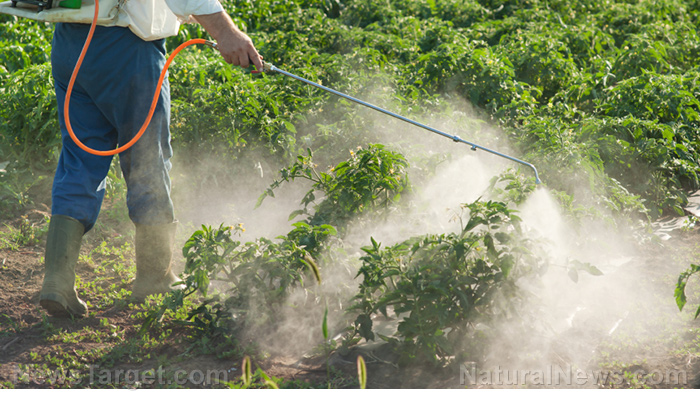Ethion – toxicity, side effects, diseases and environmental impacts
12/02/2017 / By Michelle Simmons

Ethion is an insecticide that belongs to the organophosphate chemical group. It is used as a tool to control insects, such as aphids, mites, scales, thrips, leafhoppers, maggots and foliar feeding larvae, on citrus tress, cotton, fruit and nut trees, and some vegetables. In addition, it is used on lawns and turf grasses, but not in homes for pest control. Like all other organophosphates, it works by disrupting the activity of cholinesterase, an enzyme that is important for the proper working of the nervous system. It is characterized as a yellowish liquid with an unpleasant sulfur-like smell and is available in different formulations, such as dust, emulsifiable concentrate, emulsifiable solution, granular and wettable powder formulations. Ethion has the molecular formula of C9H22O4P2S4. This insecticide is banned in most countries except in Canada and Australia.

List of known side effects
According to an entry by the Centers for Disease Control and Prevention (CDC), ethion can cause irritation in the eyes and skin, nausea, vomiting, abdominal cramps, diarrhea, salivation, headache, dizziness, weakness, exhaustion, rhinorrhea or discharge of thin nasal mucus, chest tightness, blurred vision, miosis, muscle fasciculation, and dyspnea or breathing difficulty.
Ethion can cause poisoning to humans. Similar to organophosphorus compounds, ethion poisoning can cause symptoms such as excessive salivation, sweating, rhinorrhea and tearing. It can also cause muscle twitching, weakness, tremor, incoordination, headache, dizziness, nausea, vomiting, abdominal cramps and diarrhea. Moreover, it can cause respiratory depression, tightness in chest, wheezing, productive cough, fluid in lungs and pin-point pupils sometimes with blurred or dark vision. In severe cases, it can cause seizures, incontinence, respiratory depression and loss of consciousness. In addition, it can cause cholinesterase inhibition.
For its environment consequences, ethion is very toxic to the aquatic environment.
Body systems affected by ethion
The body systems that ethion adversely affects are the ocular, integumentary, digestive, respiratory, nervous and muscular systems.
Items that can contain ethion
The items that can contain ethion are those insecticide products that are used to kill pests, such as red spidermite, planthoppers, aphids, scale insects, and codling moth in apples, pears, citrus, onions, cotton and cereals. The products that use ethion as an active ingredient are identifiable in the trade names of Ethanox, Ethio, Ethiomobeed, Ethiol, Hylemox, Nialate, Rhodiacide, Rhodocide, RP-Thion, Tafethion and Vegfru Fosmite.
How to avoid ethion
The possible routes of exposure of ethion are through inhalation, skin contact, eye contact and ingestion. One of the ways to reduce or avoid ethion exposure through inhalation is to use local ventilation at the site of chemical release. However, if this is not available, it is advised to wear an appropriate respirator. In order to avoid skin contact, wear protective gloves and protective clothing, such as suits, footwear and headgear. In order to avoid eye contact with the chemical, it is important to wear an indirect-vent, impact and splash resistant goggles with a face shield. Since it can be toxic if ingested, it is important to wash hands thoroughly before eating, drinking, smoking or using the toilet. Moreover, where ethion is handled, processed or stored, it is important to keep in mind to refrain from eating, smoking or drinking.
Where to learn more
Summary
Ethion is an organophosphate insecticide that is used to kill insect pests on citrus tress, cotton, fruit and nut trees, and some vegetables.
Ethion poisoning can cause excessive salivation, sweating, rhinorrhea, tearing, muscle twitching, weakness, tremor, incoordination, headache, dizziness, nausea, vomiting, abdominal cramps, diarrhea, respiratory depression, tightness in chest, wheezing, productive cough, fluid in lungs, and pin-point pupils oftentimes with blurred or dark vision.
Ethion can cause irritation in the eyes and skin, nausea, vomiting, abdominal cramps, diarrhea, salivation, headache, dizziness, weakness, exhaustion, rhinorrhea, chest tightness, blurred vision, miosis, muscle fasciculation, and dyspnea.
Ethion adversely affects the ocular, integumentary, digestive, respiratory, nervous, and muscular systems.
Ethion is highly toxic to the aquatic environment.
Sources include:
Tagged Under:



















